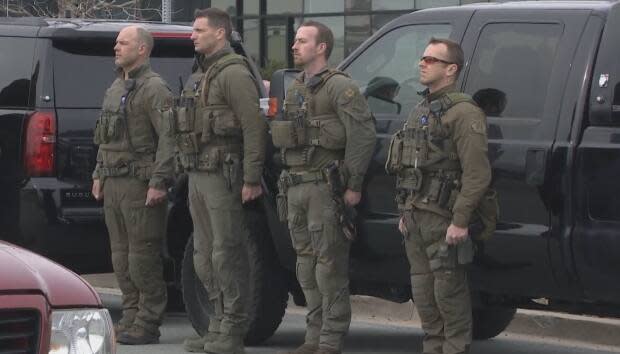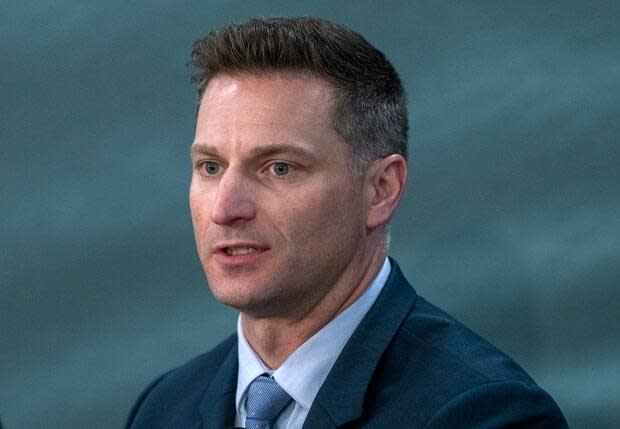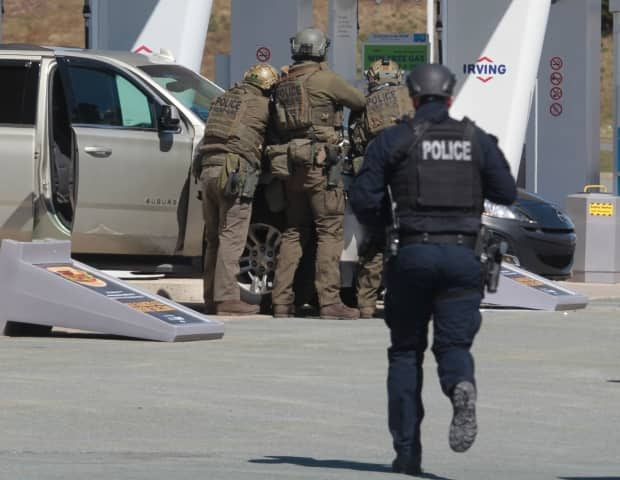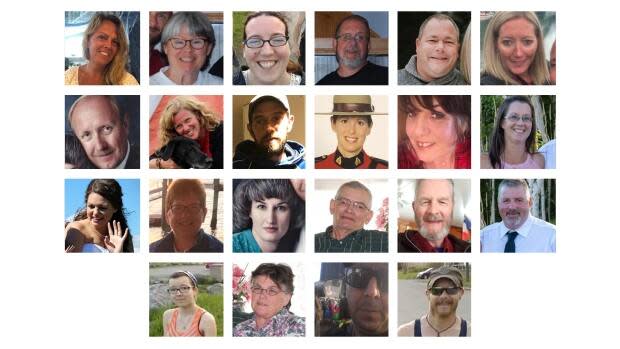Retired tactical officer calls RCMP 'broken organization' at N.S. mass shooting inquiry

Two RCMP tactical officers testifying Monday at the inquiry examining the 2020 Nova Scotia mass shooting say responding was made more challenging by not having an adequately staffed team, overnight air support or the technology to pinpoint their locations.
Emergency Response Team leader Cpl. Tim Mills, who decided to retire six months after the shootings, and Cpl. Trent Milton, who took over team leader responsibilities, answered questions together in a witness panel.
In his testimony, as in his behind-the-scenes interview, Mills said he was proud of his team's efforts but didn't hold back criticism of his former employer, calling it a "broken organization."
"The RCMP as an organization wants to give this impression they care about their members.... Commissioner Brenda Lucki has said herself, 'We'll do whatever we can. We can't do enough.' The way we were treated after this is disgusting, absolutely disgusting — it's why I left the RCMP," he said Monday morning.
He said senior management failed to support tactical officers in the weeks after the mass shooting by turning down a request for time to debrief together.

Mills said he proposed having the team work on administrative tasks at headquarters for two weeks in hopes it would help them process together the trauma they experienced.
But despite initial support from psychologists who met with the team, he said the eight part-time members of the group were told to return to their regular front-line duties in their home detachments or take sick leave.
"There are members off today because of Portapique, not working, that didn't see what we [saw]," said Mills. [They] didn't experience what we experienced. We were at multiple sites, multiple casualties and they forced our guys back to work, our part-timers back to work, a week and a half after."
Wanted to keep busy, together
Milton, who is still working, was more measured, but testified the recommendation to debrief together was consistent with what he'd learned at a SWAT team leadership course.
He said the instructor shared best practices for mental health support developed after other mass shootings, like the 1999 Columbine High School massacre in the U.S., where high numbers of first responders left their positions afterward.
They were told that teams should "keep busy, you need to keep together and be with like-minded individuals. And that's all we were asking for at that point in time," Milton said.
In his interview with commission investigators, Milton said the weeks after the mass shooting were difficult because of the refusal to allow part-time members to take two weeks away from front-line duties.
"It was kind of a huge jab … you're telling me I now need to go home and sit in my basement by myself and try to cope with this by myself," Milton told the inquiry in his interview. He remained at work but others took leave.

While some senior officers were supportive, Milton said there were "huge gaps" that "went beyond disrespect" and reflected "ignorance" of what they were going through.
He said, for example, the division's commanding officer, now-retired Assistant Commissioner Lee Bergerman, never met directly with ERT after the mass shooting. He said Chief Supt. Chris Leather, who ultimately came to oversee the tactical team, didn't show up for a meeting to discuss mental health strategies.
"The RCMP is very good at talking the talk and putting out that we've got all these mental health strategies in place, but the action implementation is…is severely lacking," Milton told commission investigators.
Previous requests for larger ERT denied
In April 2020, the tactical team had five full-time members and eight part-time officers who assisted with high-risk situations across Nova Scotia, often barricaded people and calls that involved weapons. After learning of an active shooter in Portapique around 10:45 p.m. AT on April 18, Mills alerted everyone and they assembled at the RCMP's Dartmouth headquarters and rushed to Colchester County.
The inquiry determined they arrived at the scene between 12:35 a.m. and 1:15 a.m. ERT took over the lead on the ground from the general duty officers who were first on the scene.
Both Mills and Milton testified the team was five members short of what had previously been recommended and typically only eight members were on call.
All 13 members responded on April 18, 2020, but Mills said that wasn't unusual. He said despite not approving multiple proposals to expand the unit, management was "getting their cake and eating it too" because his team was keen to help.
"Most of the time you were getting more than eight guys. Even the guys that weren't on call, were answering that call, because that's what we love to do," he testified.
Milton said since the mass shooting, ERT has grown to 12 full-time members and there is a proposal with the Department of Justice to add six more full-timers in the next three years. He said they now require a minimum of 12 members to respond to a call.
Drew on Moncton experience
The commission's report released Monday summarized the team's actions in Portapique, Glenholme, Debert, Shubenacadie and Enfield.
Milton and Mills said what they faced was unlike any specific scenario they'd encountered in training and it drew on many of their skills.
But many ERT officers had responded to the 2014 Moncton shooting, in which a gunman shot five Mounties, killing three and injuring two others. Mills said being there and living through that experience was "good exposure and gave us a very good idea of how to deal with something like that."

The tactical team spent the early-morning hours following up on possible sightings of the gunman, including nearly two hours — between 1:20 a.m. and 2:20 a.m. and then again from 3:25 a.m. to 4 a.m. — spent clearing properties slightly west of the subdivision where the gunman had killed 13 neighbours.
They also picked up Clinton Ellison, a man who had been hiding in the woods for hours after discovering his brother Corrie's body, checked for vital signs on victims and surveyed the gunman's burning properties.
For more than three hours, starting at 12:45 a.m., the Mounties were communicating on an unencrypted radio channel, which meant anyone with a scanner could have tuned in to hear the transmissions between the officers on the ground, their commanders and the dispatch centre. The commission found using this public channel was an error but it didn't explain why exactly it happened.
No ability to track locations on phones
During those overnight hours, they had to rely on dispatchers to verbally explain directions over the radio.
Mills and Milton testified they previously had access to an app that allowed them to see team members' locations on a map of the area. But the app expired and replacement devices they were using needed upgrades and had been sent to Ottawa six weeks previously.

Mills said listening back to recorded communications illustrates the "total confusion" that resulted in attempts to convey locations verbally.
"It was totally pitch black that night, poorly marked roads, rural area, trying to figure out where to go that night without that ability was frustrating and tough to do," Mills told the inquiry.
They agreed having the app wouldn't have changed the outcome but they thought it would've allowed them to complete tasks faster.
'Still fighting' for GPS software
Milton said one of the recommendations that came from the independent review into the Moncton shootings was for GPS tools. Through pilot projects, he said they'd come to rely on the apps "quite heavily" and they "were basically blind as far as situational awareness" without them.
Since the 2020 mass shooting, Milton said all RCMP tactical officers in Canada are using new software and he said a year ago he was told it would also be available to all general duty members, but that has yet to happen.
"It's still taken longer than it needs to. We're now eight years post-Moncton and a very simple software app that would provide much better situational awareness at all levels, we're still fighting to get it where it needs to be," he testified.

Overnight, the RCMP didn't have access to any air support, something Mills testified "would've helped a lot." The only helicopter for the Atlantic region was down for maintenance, something Mills and Milton said wasn't unusual.
The inquiry found the Department of National Defence declined to provide one of their helicopters for an active shooter situation and a provincial one couldn't fly until dawn.
Air support not available 24/7
Milton said the RCMP "certainly have issues surrounding air support" and that people still expect a response around the clock, despite there not being any contingency plans for backups.
In April of 2020, Milton was a drone operator and the only one on scene. Though his equipment could be used at night, he said the priority was helping focus on other tasks. The equipment took time to get in the air and the view was limited that night because of the low cloud cover, thick trees and because they couldn't let the drone out of their sight, he testified.
Around 6:15 a.m., Milton launched the drone from Orchard Beach Drive, near the gunman's garage and where police found the bodies of two people. He said in the 15 minutes it was in the air, he could see the heat signatures of some animals but no humans.
In the past two years, he said the Mounties have added smaller drones to their fleet that are also have thermal imaging and take less time to use.

When a provincial Lands and Forestry helicopter finally was available, ERT moved ahead with plans to start evacuating homes. Mills testified he wanted that aerial view to guard against any potential ambushes in the "hot zone" around the gunman's last known location given they didn't know if he was hiding in the woods.
They didn't get far though before a 911 call came in after a shooting about 40 kilometres away in Wentworth, N.S.
When they left the community, they were not aware five people were dead in their homes on Cobequid Court. They said they told the officers in charge the address they'd gone to and shifted to trying to stop the threat.
They spent the next two hours frantically trying to track down the gunman, who by then was travelling between rural communities driving a replica RCMP cruiser killing strangers.
By the time a dog handler and a tactical officer shot and killed Gabriel Wortman at a gas station in Enfield, N.S., 22 people, including a pregnant woman, a teenager and an RCMP officer, had been murdered. Others were injured and several homes destroyed by fire in the 13-hour rampage.
WATCH | RCMP officers describe confrontation with Nova Scotia gunman:
MORE TOP STORIES

 Yahoo Movies
Yahoo Movies 